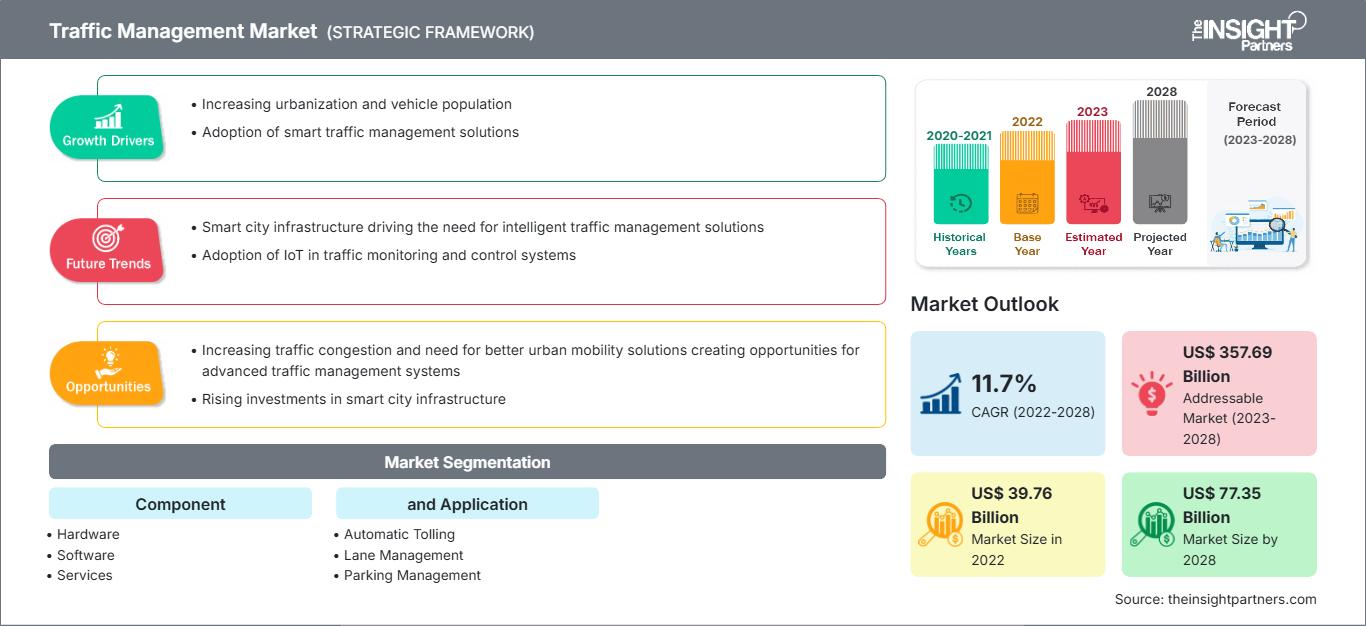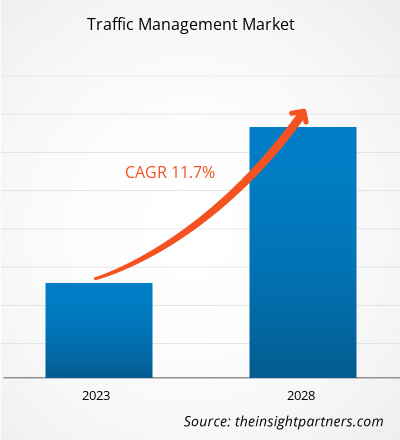Se proyecta que el mercado de gestión de tráfico alcance los US$ 77.346,44 millones para 2028 desde los US$ 39.756,74 millones en 2022; se espera que crezca a una CAGR del 11,7% entre 2022 y 2028.
La mayoría de los países han experimentado una drástica urbanización a lo largo de los años, lo que ha dado lugar a redes viales complejas y una alta congestión. El aumento de la población urbana, sumado al incremento de la propiedad de vehículos privados, incrementa el número de vehículos en circulación. La población de Mumbai, India, aumentó de 18,5 millones en 2011 a 20,4 millones en 2020, mientras que el número de vehículos privados casi se duplicó durante este período. Debido a estos factores, y para remediarlos, se estima un crecimiento del mercado de la gestión del tráfico. Además, los servicios de transporte compartido de empresas como Uber, Grab, Ola y Lyft han aumentado a un ritmo acelerado. Estos servicios han sustituido a los sistemas de transporte público, lo que ha provocado un aumento repentino de vehículos en circulación. Estos factores obligan a las autoridades gubernamentales a contactar con los actores del mercado de la gestión del tráfico para obtener soluciones eficaces. La congestión del tráfico se puede reducir eficazmente con un sistema robusto de gestión del tráfico, que incluya software, sensores, cámaras y paneles de visualización. Estos sistemas pueden instalarse en una carretera existente sin necesidad de modificar la infraestructura. De igual manera, un sistema de gestión de carriles puede gestionar eficazmente el flujo de tráfico abriendo o cerrando carriles, según la velocidad del tráfico en cada momento. Considerando las ventajas que ofrecen los sistemas de gestión de tráfico, se espera que la rápida urbanización impulse considerablemente el tamaño del mercado de la gestión de tráfico.
Impacto de la pandemia de COVID-19 en el crecimiento del mercado de gestión del tráfico
El brote de COVID-19 afectó a sectores industriales como la automoción, la manufactura, la energía, la aeroespacial y la defensa, y la construcción en 2020. El continuo crecimiento de pacientes con COVID obligó a las autoridades gubernamentales de Estados Unidos y otros países a imponer confinamientos estrictos durante los tres primeros trimestres de 2020. Esto provocó una disminución significativa del transporte en todos los países. La implementación de medidas de contención, como prohibiciones comerciales, restricciones de viaje y limitaciones de personal, afectó las actividades de fabricación, suministro y ventas de diversas empresas, incluidas las que ofrecen hardware, software y servicios de gestión del tráfico. El sector manufacturero sufrió graves pérdidas debido al cierre temporal de fábricas y a los bajos volúmenes de producción, lo que también dificultó la producción de sistemas de hardware de gestión del tráfico. En Estados Unidos, el gobierno federal y estatal se centró más en abordar la pandemia; como resultado, la instalación de hardware y software de gestión del tráfico se suspendió temporalmente. La industria europea de gestión del tráfico se vio gravemente afectada debido a una disminución de aproximadamente el 20 % en el gasto en proyectos de infraestructura, lo que provocó retrasos y la interrupción de varios proyectos de ciudades y carreteras inteligentes. El aumento de los precios de los semiconductores y la interrupción de las cadenas de suministro agravaron aún más la situación. Sin embargo, el mercado de gestión del tráfico comenzó a experimentar un crecimiento positivo en el cuarto trimestre de 2020.
Obtendrá personalización en cualquier informe, sin cargo, incluidas partes de este informe o análisis a nivel de país, paquete de datos de Excel, así como también grandes ofertas y descuentos para empresas emergentes y universidades.
Mercado de gestión del tráfico: perspectivas estratégicas

- Obtenga las principales tendencias clave del mercado de este informe.Esta muestra GRATUITA incluirá análisis de datos, desde tendencias del mercado hasta estimaciones y pronósticos.
Perspectivas del mercado: Mercado de gestión del tráfico
El mundo está experimentando un auge en los dispositivos conectados, y varios países están invirtiendo en el desarrollo de ciudades inteligentes. Estas ciudades son áreas urbanas tecnológicamente avanzadas que emplean diversos sensores y métodos electrónicos para recopilar datos y utilizarlos para el mejoramiento de la localidad. Están diseñadas con planes a largo plazo para gestionar el tráfico, optimizando el transporte y la logística, y reduciendo la congestión. Por lo tanto, junto con las ciudades inteligentes, los países también están invirtiendo en el desarrollo de carreteras inteligentes para proporcionar un desplazamiento vehicular más seguro. En las carreteras inteligentes, diferentes tipos de sensores y hardware recopilan datos multivariables que se utilizan para monitorear el tráfico. Estos datos también se pueden compartir con los vehículos que circulan por la carretera, lo que permite a los conductores y pasajeros tomar decisiones informadas. Por lo tanto, se espera que la creciente adopción de ciudades y carreteras inteligentes impulse el tamaño del mercado de la gestión del tráfico.
Información basada en componentes
El mercado de la gestión del tráfico está segmentado según componentes, aplicaciones y geografía. El mercado, por componente, se divide en hardware, software y servicios. El mercado de hardware se segmenta a su vez en cámaras, paneles de visualización y sensores; el mercado de software se bifurca en la nube y en instalaciones locales. Diversas agencias gubernamentales han invertido en la actualización de su hardware de gestión del tráfico. La creciente urbanización y el aumento de la propiedad de automóviles han sobrecargado las vías urbanas. Por lo tanto, las autoridades confían en cámaras modernas para un mejor mantenimiento del flujo vehicular y garantizar la seguridad. Las cámaras de Reconocimiento Automático de Matrículas (ANPR) se están implementando cada vez más para identificar a infractores o localizar vehículos durante las investigaciones de incidentes. A menudo se combinan con sensores láser para determinar la velocidad de un vehículo.
Por aplicación, el mercado de la gestión del tráfico se segmenta en peajes automáticos, gestión de carriles, gestión de aparcamientos, vigilancia, gestión de señales de tráfico, entre otros. Según la geografía, el mercado se segmenta principalmente en Norteamérica, Europa, Asia Pacífico (APAC), Oriente Medio y África (MEA) y Sudamérica (SAM). IBM Corporation; Cisco Systems, Inc.; Siemens AG; Hangzhou Hikvision Digital Technology Co., Ltd.; y Dahua Technology Co., Ltd. se encuentran entre los principales actores del mercado de la gestión del tráfico.
Perspectivas regionales del mercado de gestión del tráfico
Los analistas de The Insight Partners han explicado detalladamente las tendencias regionales y los factores que influyen en el mercado de la gestión del tráfico durante el período de pronóstico. Esta sección también analiza los segmentos y la geografía del mercado de la gestión del tráfico en Norteamérica, Europa, Asia Pacífico, Oriente Medio y África, y Sudamérica y Centroamérica.
Alcance del informe de mercado de gestión del tráfico
| Atributo del informe | Detalles |
|---|---|
| Tamaño del mercado en 2022 | US$ 39.76 mil millones |
| Tamaño del mercado en 2028 | US$ 77.35 mil millones |
| CAGR global (2022-2028) | 11,7% |
| Datos históricos | 2020-2021 |
| Período de pronóstico | 2023-2028 |
| Segmentos cubiertos | Por componente
|
| Regiones y países cubiertos | América del norte
|
| Líderes del mercado y perfiles de empresas clave |
|
Densidad de actores del mercado de gestión del tráfico: comprensión de su impacto en la dinámica empresarial
El mercado de la gestión del tráfico está creciendo rápidamente, impulsado por la creciente demanda del usuario final debido a factores como la evolución de las preferencias de los consumidores, los avances tecnológicos y una mayor conciencia de los beneficios del producto. A medida que aumenta la demanda, las empresas amplían su oferta, innovan para satisfacer las necesidades de los consumidores y aprovechan las tendencias emergentes, lo que impulsa aún más el crecimiento del mercado.

- Obtenga una descripción general de los principales actores clave del mercado de gestión del tráfico
Los actores del mercado de gestión del tráfico se centran principalmente en el desarrollo de productos avanzados y eficientes.
- En 2021, Dahua Technology anunció el desarrollo de una solución integral de gestión de tráfico inteligente que se desarrolló combinando videovigilancia con IA, ANPR, fusión de imágenes, AR y otras tecnologías de vanguardia para satisfacer las diversas necesidades de los departamentos de control de tráfico modernos.
- En 2021, Hikvision, proveedor de soluciones IoT especializado en cámaras, presentó la cámara ITS All-Rounder, su nuevo producto de tráfico, diseñado para mejorar la seguridad vial y la fluidez del tráfico. La cámara combina diversas funciones y capacidades, como detección de velocidad, detección de infracciones de tráfico, identificación automática de matrículas y análisis de atributos de vehículos, todo en un solo producto.
- Análisis histórico (2 años), año base, pronóstico (7 años) con CAGR
- Análisis PEST y FODA
- Tamaño del mercado, valor/volumen: global, regional y nacional
- Industria y panorama competitivo
- Conjunto de datos de Excel
Informes recientes
Informes relacionados
Testimonios
Razón para comprar
- Toma de decisiones informada
- Comprensión de la dinámica del mercado
- Análisis competitivo
- Información sobre clientes
- Pronósticos del mercado
- Mitigación de riesgos
- Planificación estratégica
- Justificación de la inversión
- Identificación de mercados emergentes
- Mejora de las estrategias de marketing
- Impulso de la eficiencia operativa
- Alineación con las tendencias regulatorias




















 Obtenga una muestra gratuita para - Mercado de gestión del tráfico
Obtenga una muestra gratuita para - Mercado de gestión del tráfico